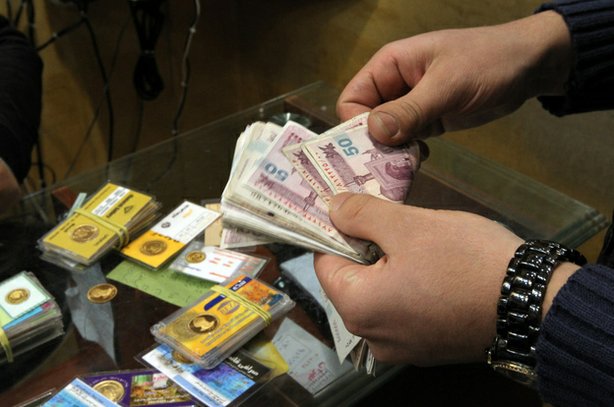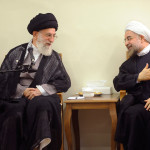by Djavad Salehi-Isfahani
The sharp drop in the value of the rial in the last two weeks has created much excitement in Iran and abroad, but mostly for the wrong reasons. In the parallel (or free) market for foreign currencies, the rial fell by 15% in one day this week, reaching its lowest value ever — 35,000 rials per US dollar — down by more than 50% compared to a month ago and 300% to last December when international sanctions tightened against Iran.
What all the related excitement overshadows is that this devaluation is not comparable to those in other countries where large devaluations caused severe shocks to the economy, such as those that swept through Asia in 1997-98. That’s because in those situations all prices were affected because all foreign exchange was traded at the same (rising) rate. This is not the case in Iran because nearly all foreign exchange is earned by the government, which has decided to sell most of it at a lower rate for the import of goods and services that it deems essential.
The rial devaluation that has created the media excitement is actually taking place in a narrow market that is shrinking in size and diminishing in importance. Iran’s Central Bank has classified a long list of goods into categories with priorities 1 through 10, leaving it to the parallel market to take of all other needs. Priorities 1 and 2 are food and medicine, receiving foreign exchange at the official rate of 12,260 rials per dollar, followed by other categories with lower priorities, which are mostly intermediate goods used in industrial production.
The government has been promising to do something for the import of these non-essential but important commodities, which account for about two-thirds of Iran’s imports, offering them some sort of preferential treatment. But the Central Bank was slow to respond and those producers who did not want to wait bought their currency needs in the parallel market, competing with speculators and people taking their money out of the country. The uncertainty about the sanctions, bewildering pronouncements from government officials in Iran, and hype over a possible Israeli attack, all combined to throw this market into chaos.
To protect Iran’s producers from what the government considers the consequences of “psychological war”, the Central Bank set up a “Currency Exchange Center” and invited licensed importers and exporters to trade their foreign currencies there, hoping that the auction rates reached there would be more stable and lower than the parallel market rate. When the Exchange Center opened just two weeks ago, the volume of transactions quickly jumped from $10 to $181 million per day, with most of the supply likely coming from the Central Bank. The Exchange Center diverted some of the supply of currency away from the parallel market, which I believe caused the rate there to soar.
Curiously, the Central Bank had predicted the opposite: that by arranging trade in the Exchange Center it would help lower the rate in the parallel market. This miscalculation added to the confusion and fear that the government did not know what it was doing. While the Exchange Center has produced a lower rate than the parallel market and can potentially shield producers from the worst psychological effects of sanctions and war, the shock to the parallel market has caused a serious political if not economic crisis for the government of Mr. Ahmadinejad.
Does all this mean that Iran’s economy is on the verge of collapse, as Israel’s Finance Minster reportedly said? The answer is no, because most of the economy is shielded from this exchange rate, though not from the ill effects of the sanctions, which will continue to bite for a while. Would it cause sufficient economic pain that would push the Iranian government to make concessions in its nuclear standoff with the West? The answer is not likely. The multiple exchange rate system, as inefficient as it is, will protect the people below the median income, to whom the Ahmadinejad government is most responsive.
But the government can ill afford to ignore millions of Iranians, mostly upper income Iranians, who are affected by the gyrations of the parallel market. Among them are millions of people who are seeking a safe place for their savings, parents who send money to their children for education abroad or need to travel there to see them. They are not all importers of luxury items or those who want to take their money out of Iran. In allocating its limited — perhaps shrinking supply of for foreign currency — the government has a difficult time balancing the needs of the lower middle class and the poor with those of upper income Iranians that it cannot rely on for political support.






Here is an idea that may help the Iranian economy. Iran is having hyperinflation and it is also one important oil producer. Iran could start selling oil at an attractive discount if the oil is paid in the Iranian currency. The discount would be calculated using the current exchange rate with EUR. In this way, several countries would rush to sell products to Iran in order the get the Iranian currency to later pay for the oil. This will increase the demand for the Iranian currency and could even completely reverse the hyperinflation.
For more than ten years Iranian economy suffered from an inflation rate of around 20 percent annually, while self-serving top bureaucrats kept pegging Iranian Rial at a fixed parity of close to 10,000 Rials per dollar. Sustaining this over-valued Rial, has cost the treasury hundreds of billions of dollars in oil revenues and damaged the farming, manufacturing and non oil exports sectors of the economy. Meanwhile, they were enriching themselves, the civil servants and the upper middle class, while impoverishing farmers and manufacturers through cheap imports. Squandering money on luxury imports (thousands of Porsche and Bugatti ….cars) and vacations in expensive hotels on Mediterranean shores (not the Caspian) became a status symbol.
Now, thanks to sanctions, those top bureaucrats have come to their senses and allowed the Rial to slip to its real market value. Thus, reducing the budget deficit by timidly selling petrodollars and gold on this secondary market, while blaming currency speculators for the further increase. Of course this inconveniences the millions of civil servants and their families, mostly populating Tehran, and benefiting from years of cheap imports. They will not like the devaluation, and are likely to be complaining openly. The manufacturers, the workers, the farmers and specially the exporting industries are benefiting from the new situation. The country should see increase in both GDP and employment after some initial adjustment. Already cement exports are double the same months of last year, and there is a noticeable trend towards using more local products in the construction, finishing and furnishing of new buildings. Iranian economy would gain substantially from this timely devaluation.
Sanctions have acted as cathartic agent for a nation that once prided itself on creating extensive irrigation networks in the desert through its own labor over several generations. Indeed more than 50,000 qanats (kariz), and the towns and farms created around them represented the largest long-term per capita investment the private sector had achieved in any country until modrn times.
The Iranian people, over several thousands of years, have survived plots and schemes hatched by more intelligent foes than the ‘coalition of unwilling’.
Mr. Isfahani’s analysis is not based on current facts in Iran. I’m an economist in Iran. All signs of an economic collapse and hyperinflation are in place. The following are the indications:
1- It is believed that the gov. has only achieved 30% of its total predicted revenue. It’s printing money to compensate for its budget shortcomings.
2- Liquidity has passed the 400 trillion toman mark with a growth rate of 30% (very inflationary). It is expected to reach higher rates.
3- Many industries including the auto (2nd largest after oil), cement, textile, petrochemical, etc. on the verge of complete bankruptcy.
4- The banking system is in dire shape. State-owned banks are practically bankrupt. And the private ones are dragging their feet. The amount of delinquent loans is accelerating. The official figure points to over 60 trillion tomans but the unofficial figure is much higher.
5- The oil industry needs $100 billion investment per year for the next few years. Unless sanction lifted, there is no way to invest in it.
6- Oil exports has dropped to below 800,000 per day compared to 2,6 million last spring.
7- Rent opportunities are enormous and contrary to what Mr. Isfahani said maybe essential goods are imported with the dollar rate of 1,226 but they are sold with much higher rates on the market.
8- Again contrary to Mr. Isfahani’s claim prices are very dependent of the FX rate. Day increase of prices are very tangible.
Therefore, the credibility of his analysis is very much in question!
The following article is from Donya e Eghtesad newspaper in Iran. The article is in Persian. I apologize from English speakers.
The article is exactly contrary to what Dr. Isfahani claims. The mechanism that the Central Bank of Iran has put in place and Dr. Isfahani explains and justifies is futile and dysfunctional …
??? ??? ???? ?? ?????
???? ???????? – ?? ?????? ???? ?????? ???????? ???? «1226 ??????» ?? ???? ?? ?? ???? ????? ??? ?? ?? ??? ?????????? ????? ?????? ???. ?? ??? ?? ??? ????? ?? ????? ????? ??????? ???? ??? ???? ????????: «??? ????? ???? ??? ??????? ????? ??????? ???????? ?? ????? ?????? ???? ??? ?????? ?????? ??????? ? ???????? ?? ?? ??? ???? 1226 ???? ???? ??? ???? ?? ???? ??? ????? ???? ?????? ? ?? ??????? ?????? ??????.»
????? ??? ????? ?? ??? ???????? ?? ??? ???? ?? ???? ???? 1226 ?????? ???? ?????? ???? ???? ?? ??? ????? ? ???? ???? ??????? ?? ????? ??? ??? ?? ???????? ???? ?? ??? ??? ?? ???? ?? ???? ?????? ???? ???? ????. ??? ??????? ?? ???? ???? ??????? ???? ? ???? ???? ???????? ????? ???? ??. ????? ???? ?? ??? ????? ????? ?? ????????? ?? ?? ????? ???? ?? ????? ??? ????? ??? ???? ?? ???? ???? – ???? ???? ?????? ?? ???? ???? ??????? ???? ??? ???????: «???? ??????? ???? ???? ???? ????? ???? ????? ???? ???? ?????????? ??? ???? ???????? ??? ???? ???? ??? ????? ????? ??? ? ????? ????? ?? ??? ????? ?????? ????.»
?? ??? ????? ???? ???????? ???? ??????? ???? ? ???? ???? ???????? ????? ???????: ???? ??????? ?? ??? ??? ?????? ??????? ???? ??? ?????? ???? ??????????? ??? ??? ?? ??????? ?????? ???? ????? ??????? ???? ???? ?? ???? ???????? ????? ?? ??? ??? ????? ????.
?? ??? ????? ??????? ???? ???? ???? ??? ??????? ???? ? ???? ???? ????? ?? ????? ???: ??? ????? ???? ???????? ? ?????????? ???????? ??? ?? ?? ????????? ????? ??? ?? ??????? ????? ???? ?? ???: ?? ????? ??????? ????? ???? ???? ?????? ???? ???? ?????? ???? ?????????? ??? ????? ???? ?? ?? ?? ????? ????????? ?????? ???? ??? ?? ????? ???????? ?? ???? ?? ????? ??? ??? ???? ??? ???? ??? ?????? ?????.
???? ??? ???? 1226
?? ?????? ??????? ?????? ???? «??? ????» ?? ?? ????? ?? ?????? ???? ????? ??? ???. ??? ???? ????????? ???? ????? ????? ??? ?? ?????? ?? ?????????? ?? ??? ????? ??? ????? ?? ?????????? ???? ?? ?? ????? ?? ????? ????? ??????? ?? ???? ?????? ?? ??? ?????? ???? ??????? ???????. ?? ???: ???? 1226 ?????? ?? ?? ???? ????? ??? ? ?? ??? ?????????? ????? ??????? ? ???????? ?? ?? ??? ???? 1226 ???? ???? ??? ???? ?? ???? ??? ????? ???? ?????? ? ?? ??????? ?????? ??????. ???? ???? ???? ???? ?????: ??? ????? ?? ???? ??? ??????? ?????? ???????? ?? ?????? ???? ??? ?????? ?????? ???????.
?????? ??????? ?????? ?????? ????? ?? ????? «???? ????? ??????» ??? ??? ?? ????? ??? ???? ??????? ?? ????? ???? ?????? ???? ?????????. ?? ?????? ??????? ??? ?? ???? ?? ??????? ? ????????? ???? ????? ??? ?? ??? ?? 5 ???? ????? ?? ???? ??? ?????? ???? ?? ??????? ????? ???? ?? ?? ??? ????? ????? ??? ??? ?????? ???.
???? ????? ?????? ??? ???? ????? ??? ?? ??? ???? ???: ???? ???? ???? ?? ???? ? ???? ??? ? ??? ?? ????? ?? ????? ????. ?? ?????? ??? ???? ? ???? ??? ? ??? ???? ??? ? ???? ??? ?? ?? ????? ???? ???. ??? ??? ???? ????????? ???? ????? ????? ???: ????? ?? ????? ????? ?? ??????? ??? ??? ?? ???? ???? ??????? ??? ?? ????? ????? ??? ????? ??? ?? ??????? ?? ??? ?????????.
??? ??????? ???? ????? ??????? ???????? ?? ?? ???? ??????? ???? ?????? ? ???? ?????? ???? ????????? ???? ?? ?? ?????? ??????? ???? ????? ???? ? ????? ??? ????? ??? ?????? ??? ?????? ??? ????? ??????? «???? ??????» ?? ?? ????? ???? ?? ???? ?????????.
????? ??????? ???? ? ???? ???? ????? ?? ???? ???? ??? ????? ?????: ??? ???? ? ??????? ???? ????? ???? ? ????? ?? ????? ???????? ???? ?????? ????? ?? ???? ??? ????? ???. ?? ??? ????? ???????? ???? ??????? ????? ???: ??????????? ??? ????? ?? ??? ????? ??? ?? ??? ???? ????? ???? ? ????? ?? ??? ???? ?? ?????? ???? ???. ??? ??? ???? ????????? ???? ????? ?????: ???? ????? ???? ? ????? ????? ?? ????? ???? ??????? ???? ?????? ??????? ??? ?? ?? ??? ?????? ???? ?????? ???? ???? ???? ??? ?? ?? ???? ???.
???? ????? ????? ??? ?? ??? ??????? ???? ????? ???? ? ????? ?????? ??? ? ?????: ???? ????? ????? ?????? ? ??????????? ???? ?? ????? ??? ???? ?? ???? ????? ???? ? ?????. ??? ??? ???? ????????? ???? ????? ?? ????? ??????? «????? ???? ?? ????» ?? ???? ???????? ??????? ? ????? ???? ?? ?? ???? ???? ?? ?????? ?? ??? ???? ???? ? ?????????? ???? ?? ????? ???? ?? ??? ??? ???? ???????. ?? ?????? ?? ???? ?? ????? ??????? ??? ? ???? ???? ?????? ?? ???? ??? ??? ? ?????: ???? ????? ?? ??????? ?? ???????? ???? ??? ??? ??? ?? ???? ???? ?? ???????? ?? ??? ??????.
Unlike Mr. Azad I am not an economist but a businessman living in a town in central Iran. I know, first hand, the following assertions to be true:
– Most farmers in our area are benefitting from Rial devaluation. They are selling farm products at close to world prices at free market parity, while buying inputs only 20-30 per cent higher than a year ego. They are not so much dependent on imported goods or food items.
– over the past four years the price of cement has gone up only by 25 per cent, thanks to an over capacity of 15 million tons. Non-the-less, on 3rd Ocober the cement plant close to where I live has increased its profit estimate for the current Iranian year by 80 per cent, sighting higher revenues from exports at new exchange rate. I know because I am a shareholder. Iran’s cement exports have almost doubled so far this year compared to the same period last year. The inputs are marl (clay and limestone), gas and electricity – all dirt-cheap in Iran.
– Although oil exports are down, but please do not forget that if we were importing the energy we use, like Turkey, the Iranian nation would have had to pay an additional bill to the tune of USD 120,000,000,000.-. Whether we are squandering it or saving it is a different matter! What more do we want from the oil industry? With that massive subsidy, which at present exchange rate would amount to Rls 3,600,000,000,000,000, are we still a poor nation unable to take care of ourselves?
Forgive me for meddling in your learned discussion.